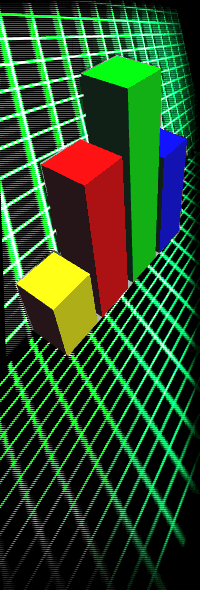What is Market Share?
A share of the market a company has represents how many units a company has sold compared to
other companies that company is competing with. For example, in 1997, the Sony Playstation had 50% of the market, the Nintendo
64 had 40%, and the Sega Saturn had 10%. That means that the Playstation is the most commonly owned console, with the N64
in second, and the Saturn in third. So that means that for every 10 gamers, five of them owned the Playstation, four owned
the Nintendo 64, and one owned the Sega Saturn.
What was the Great Crash of 1983?
In 1981, many companies thought video gaming was just a fad, and video games would lose popularity
in a year or two. Because of that, game companies wanted their games out as soon as possible. So, alot of games came
out in 1981, and so few games came out in 1982. This, along with the release of the two worst video games of all tine: E.T.,
and a special version of Pac-Man ruined video games' reputation. So in 1983, almost nobody played video games, and Atari and
almost every other game company went under extremely hard times (Many went out of business). Nintendo, followed by Sega, took
advantage of this, and took over the market. It took a long time for the industry to recover.
What is an Add-On?
An add-on is a system you can attach to another system to enhance the main systems capabilities.
Examples of this are the Sega CD, which you attach to a Sega Genesis/Mega Drive, and allows your Genesis to play CD games.
The Sega 32X turned your 16-bit Genesis/Mega Drive into a 32-bit system.
Another one was the Nintendo 64DD, which was only released in Japan and was a huge failure. Not a
single add-on was ever a success, and not a single company in a long time had made an add-on for their system, because of
the huge risk and likelihood of losing a ton of money.
What are Bits?
Bits are sort of like pieces of graphics that developers draw, and when put together, create something
in a game. The more powerful a system is, and the better graphics it has, the more bits it can process. For example, systems
from the 80's were 8-bit, systems from the early 90's were 16-bit, therefore twice as powerful as the 8-bit systems, and so
on and so forth. The point is, the more bits, the more graphics.
What are the Console Wars?
The console wars is a term used to describe the competition between a group of consoles "fighting"
to obtain the greatest market share. For example, the world's most popular console that triumphed over it's competition is
considered to be the "Winner" of the console wars while the console(s) that had a smaller market share could be considered
the "Loser".
What are Ports?
Ports are games from other systems that are put onto other systems that have usually been downgraded
in some way for the sake of the specific capabilities of the system it has been ported onto. However, somtimes, the game is
improved in some way, shape, or form.
What is a Third-Party Company?
A third-party company is a company that is not owned by any of the "Big Three" (Nintendo, Sony Computer
Entertainment, and Microsoft Game Studios). Third-party companies don't make consoles, they make games (That are usually for
multiple consoles). Examples would be EA, Ubisoft, Sega, Atari, Activision, etc. Third-party support is essential for the
success of a console. It is very rare for a console to be a success when it doesn't have much third-party support, with the
exception of a few consoles, specifically the Nintendo 64 and Gamecube.
What is a First-Party Company?
Nintendo, Sony Computer Entertainment, and Microsoft Game Studios are all first-party companies.
A company that makes consoles is considered to be first-party. A company that is owned by a first-party company is also considered
to be first-party. For example, alot of people think Nintendo makes Super Smash Bros, but they don't. Hal Labratories does. Hal
Labratories is a company OWNED by Nintendo. The Super Smash Bros. games are made by Hal Labratories, but published and
funded by Nintendo.
What is a Genre?
A genre (pronounced john-ra) is a specific style a game follows, like a book. There are fictional
books, historical books, etc. It's the same for video games, too. There are shooting games, platforming games, action-adventure
games, racing games, and so on.
What is ESRB?
ESRB, (the Entertainment Software Rating Board) is the company in charge of giving games their ratings.
For example, ESRB gave The Legend of Zelda: Twilight Princess a T for Teen rating. Here's list of ratings ESRB gives games:
C: Early Childhood
E: Everyone
E10+: Everyone 10 and Up
T: Teen
M: Mature
A0: Adults Only
RP: Rated Pending (Not yet rated).
What is Marketing?
Marketing is the style and technique of how a company advertises it's product. There are many different
and unique kinds of marketing, and different kinds of marketing can be used for different kinds of people. Good marketing
is vital to the success of any product, not just video game-related ones.
What is the NPD Group?
The NPD Group is a famous business that totals the sales of the best-selling video game consoles
and games per month. They have thousands of analysts working around the clock to predict the upcoming sales before the final
results are totalled up. VGConsole uses information from the NPD Group.
